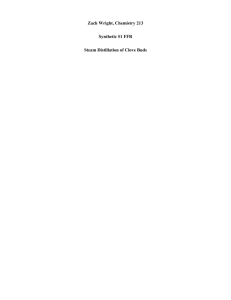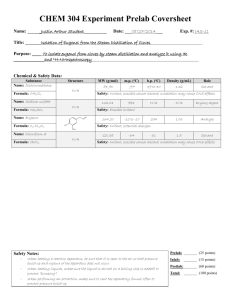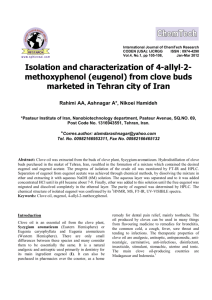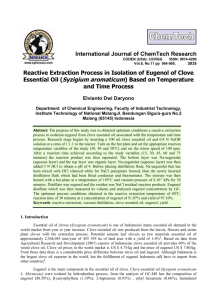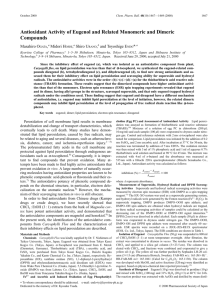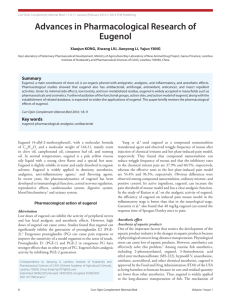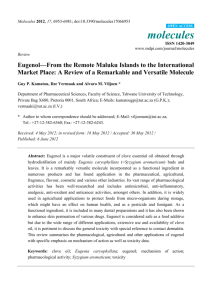Organic Chemistry Lab, Intermediate
advertisement
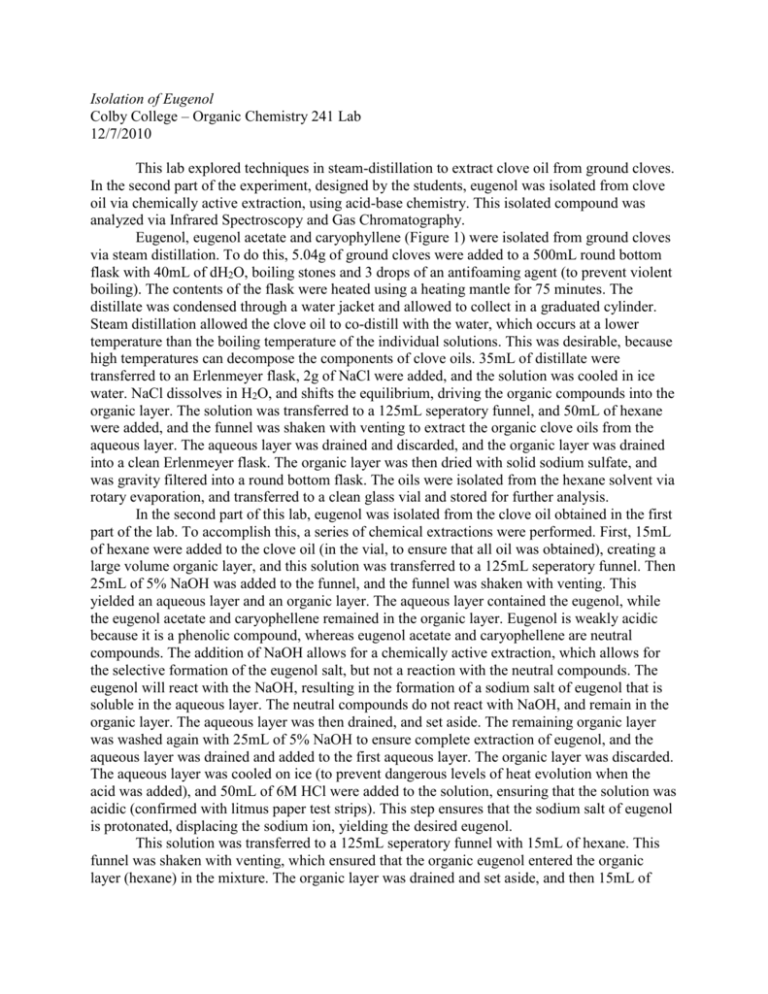
Isolation of Eugenol Colby College – Organic Chemistry 241 Lab 12/7/2010 This lab explored techniques in steam-distillation to extract clove oil from ground cloves. In the second part of the experiment, designed by the students, eugenol was isolated from clove oil via chemically active extraction, using acid-base chemistry. This isolated compound was analyzed via Infrared Spectroscopy and Gas Chromatography. Eugenol, eugenol acetate and caryophyllene (Figure 1) were isolated from ground cloves via steam distillation. To do this, 5.04g of ground cloves were added to a 500mL round bottom flask with 40mL of dH2O, boiling stones and 3 drops of an antifoaming agent (to prevent violent boiling). The contents of the flask were heated using a heating mantle for 75 minutes. The distillate was condensed through a water jacket and allowed to collect in a graduated cylinder. Steam distillation allowed the clove oil to co-distill with the water, which occurs at a lower temperature than the boiling temperature of the individual solutions. This was desirable, because high temperatures can decompose the components of clove oils. 35mL of distillate were transferred to an Erlenmeyer flask, 2g of NaCl were added, and the solution was cooled in ice water. NaCl dissolves in H2O, and shifts the equilibrium, driving the organic compounds into the organic layer. The solution was transferred to a 125mL seperatory funnel, and 50mL of hexane were added, and the funnel was shaken with venting to extract the organic clove oils from the aqueous layer. The aqueous layer was drained and discarded, and the organic layer was drained into a clean Erlenmeyer flask. The organic layer was then dried with solid sodium sulfate, and was gravity filtered into a round bottom flask. The oils were isolated from the hexane solvent via rotary evaporation, and transferred to a clean glass vial and stored for further analysis. In the second part of this lab, eugenol was isolated from the clove oil obtained in the first part of the lab. To accomplish this, a series of chemical extractions were performed. First, 15mL of hexane were added to the clove oil (in the vial, to ensure that all oil was obtained), creating a large volume organic layer, and this solution was transferred to a 125mL seperatory funnel. Then 25mL of 5% NaOH was added to the funnel, and the funnel was shaken with venting. This yielded an aqueous layer and an organic layer. The aqueous layer contained the eugenol, while the eugenol acetate and caryophellene remained in the organic layer. Eugenol is weakly acidic because it is a phenolic compound, whereas eugenol acetate and caryophellene are neutral compounds. The addition of NaOH allows for a chemically active extraction, which allows for the selective formation of the eugenol salt, but not a reaction with the neutral compounds. The eugenol will react with the NaOH, resulting in the formation of a sodium salt of eugenol that is soluble in the aqueous layer. The neutral compounds do not react with NaOH, and remain in the organic layer. The aqueous layer was then drained, and set aside. The remaining organic layer was washed again with 25mL of 5% NaOH to ensure complete extraction of eugenol, and the aqueous layer was drained and added to the first aqueous layer. The organic layer was discarded. The aqueous layer was cooled on ice (to prevent dangerous levels of heat evolution when the acid was added), and 50mL of 6M HCl were added to the solution, ensuring that the solution was acidic (confirmed with litmus paper test strips). This step ensures that the sodium salt of eugenol is protonated, displacing the sodium ion, yielding the desired eugenol. This solution was transferred to a 125mL seperatory funnel with 15mL of hexane. This funnel was shaken with venting, which ensured that the organic eugenol entered the organic layer (hexane) in the mixture. The organic layer was drained and set aside, and then 15mL of hexane were added to the remaining aqueous layer, and the extraction was repeated to ensure the complete extraction of eugenol. This organic layer was drained into the first organic layer. The organic solution was dried with anhydrous sodium sulfate, and this mixture was filtered by gravity filtration to yield a water-free organic solution in a 150mL round bottom flask. This hexane solvent was evaporated via rotary evaporation, leaving the eugenol oil behind in the flask. A sample of this oil was prepared in dichloromethane so that it could be analyzed by gas chromatography, and the rest of the oil was saved for IR analysis. The gas chromatograph (Graph 1) shows that the sample is almost 100% eugenol, with trace contamination of caryophellene, confirming efficient methods of separation and extraction. This trace impurity could be due to residue left in the glassware that was not washed away after the extractions. A sample of the eugenol oil was analyzed by infrared spectroscopy (IR). The spectrum (Graph 2) identifies functional groups present in the molecules in the solution. The presence (or absence) of these functional groups allows for the identification of molecules present. Spectral data below 1600 cm-1 is considered molecular fingerprint, and for the purposes of this lab, is not analyzed. The two peaks at 1611.81 cm-1 and 1637.77 cm-1 represent carbon-carbon double bonds that were expected in all of the isolated alkenes. No peak is observed in the 1750 cm-1 to 1735 cm-1 range, which shows that the acetate ion is not present, because no C=O is observed, so no eugenol acetate in present as confirmed by the IR. The peaks at 2938.28 cm-1 and 2842.62 cm1 represent the C-H bond in the alkanes found in all three molecules, and the peak at 3003.67 cm1 represents the C-H bond in the alkenes found in all three molecules. These three peaks are not diagnostic of any one molecule, but are expected. A peak was observed between 3580 cm-1 and 3650 cm-1 (representing an –OH functional group), this peak was observed at 3511.36 cm-1. This peak confirms the presence of eugenol because only eugenol contains an –OH functional group. The IR spectrum compares closely with a reference spectrum for Eugenol, further confirming that the IR spectrum shows the presence of Eugenol. In this lab, clove oil was isolated from ground cloves via steam distillation, which works by allowing the clove oil to co-distill with water. Using a chemically active extraction, and rotary evaporation, eugenol was isolated from this clove oil. Techniques in IR spectroscopy were used to confirm the presence of eugenol, and Gas Chromatography showed that the extraction methods were highly effective in isolating eugenol. References: Dalton, D.; Yip, M. Organic Chemistry in the Laboratory; D. Van Nostrand Company: New York, 1979; pp. 26-30, 137-142 Eugenol - Infra Red Spectrum. http://www.chem.bham.ac.uk/schools/eugenolir.htm (accessed Dec. 7, 2010). Jones and Fleming. Organic Chemistry: 4th Edition. W.W. Norton & Company, Inc: New York, 2010; pp. 710-711 Figure 1: Structural Formulas – Eugenol, Eugenol Acetate and Caryophyllene
